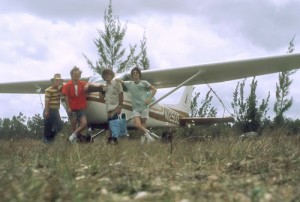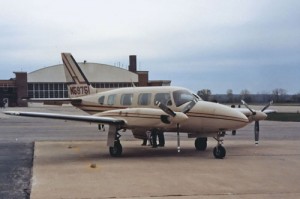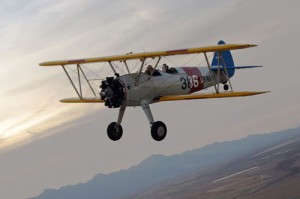
The author poses with travel companions and Cessna 12502 at Marsh Harbour Airport, Bahamas, in 1976.
By Greg Brown
“Cessna 502, the Blythe, California, altimeter setting is 29.98.”
“We used to fly an airplane with a similar N-number,” I observed to my wife, Jean, upon hearing the transmission. “Remember?”
“Was it with Sky-Vu Flyers out of Indianapolis?” she asked.
“No. I’m thinking of a Cessna 172 from the University of Illinois flying club, back when you and I were dating. We flew it back and forth to Indianapolis after you transferred to Butler University.”
We trailed the plane eastbound through Los Angeles Center airspace, and with every radio call, I was reminded of another adventure in the “502” I used to fly.
“The number I remember from those days is ‘068,’” Jean said. “What was that one?”
“You mean 98068, the Cherokee 140 with the trim crank in the ceiling. We flew that one often, because it was the cheapest Flying Illini club airplane to rent,” I recalled. “But we flew 502 plenty, too.”
That aroused memories of other planes and N-numbers from the past. The toughest call sign I’ve ever encountered was November 38383. It belonged to a nice Piper Turbo Arrow, but every call-up required several tries before ATC could get the number straight. “Center, this is Arrow 38383,” I’d say.
“38833?”
“No, 38383.”
“33833?”
“No sir: 3-8-3-8-3.”
It was maddening, especially on instrument flights where every communication counts.

Piper Navajo 59751 featured one of the toughest monikers the author has encountered. With each new radio contact, it took several attempts to convey the N-number to air traffic control.
Then there was 59751, a Piper Navajo twin. That moniker was almost as challenging as 38383, until I mastered “fife-niner-seven-fife-one,” at just the right cadence. Along with happy adventures, 751 delivered landing gear problems, gyro failures and a runaway autopilot.
“Did I ever mention tracing Richard Halliburton’s N-number?” I said to Jean. “You know, for the original Flying Carpet he flew to Timbuktu in 1931?”
Halliburton was a popular adventurer, author and syndicated columnist in the 1920s and ’30s. His black and crimson Stearman biplane inspired our own Flying Carpet.
“I don’t think so,” she replied.
“A woman wrote me last year, asking if Halliburton’s original Flying Carpet still exists,” I said. “I found the N-number in an old article—it was an NX-number, actually—and looked it up in the FAA database (minus the “X,” which is no longer used). To my astonishment, it was registered to a Stearman just across Phoenix.”
“Was it the original Flying Carpet?” asked Jean.
“No. I knew right away it wasn’t, because the listed Stearman was a 1940 model, built ten years after Halliburton’s travels. Turned out the owner was a Halliburton fan, too. Upon buying a Stearman years ago, he’d registered it under the adventurer’s N-number. Apparently, the original Flying Carpet was destroyed in a crash following Halliburton’s return, after someone rigged the controls backwards. Anyway, the woman who raised the question proved to be Halliburton’s grandniece; she actually remembered meeting the guy when she was a little girl.”
“Only you, Greg, could get excited about a 75-year-old N-number, even if it was from the original Flying Carpet.”
Before I could conjure a snappy comeback, our radio crackled to life.
“Cessna 502,” said Los Angeles Center. “Contact Albuquerque Center on 125.25.”
“Just for the heck of it…” I said to Jean, switching frequencies momentarily to hear the other aircraft’s sign-on.
For a time, all was silent, then, “Albuquerque Center, Cessna 12502, checking in at 7,500 feet.”
“That’s it!” I said to Jean. “12502! Do you realize how long it’s been since we flew that airplane?”
Like fond memories of old lovers, beloved airplanes resurface occasionally from quiet corners of pilots’ minds. We hear the last three digits of some familiar N-number and are flooded by reminiscences. But rarely do the abbreviated call signs used in routine communications fully match the numbers of actual steeds we once flew—especially when 1,500 miles and 30 years have passed under the wings.

This World War II era Stearman, owned by Billy Walker, Joe Sottile and Joe Anderson, is a descendent of the black and crimson Flying Carpet, which took adventurer Richard Halliburton and his pilot Moye Stephens across North Africa/Asia in the early 1930s.
We were approaching the Arizona border and soon would join our old friend on Albuquerque Center frequency.
“I’m going to ask those guys about 502 when we switch over,” I said to Jean.
We crossed Blythe and then the Colorado River, but our radio remained silent.
“Radio check,” I said to LA Center, thinking they needed a hint.
“Loud and clear,” was the reply, but still no frequency change. Subconsciously, I drummed my fingers on the glare shield.
“What’s with you?” asked Jean, annoyed.
“Those guys are farther ahead than I thought,” I said, retrieving my instrument flying chart. “I hope they don’t go off frequency. Darn! We’re still 24 miles from Albuquerque’s airspace!”
I requested a temporary frequency change from LA Center, and then radioed Albuquerque.
“If 12502 is still on frequency, please ask them to call me on air-to-air frequency,” I pleaded.
To my delight, I soon heard from 502’s pilot.
“Hope you don’t mind me asking, but where are you folks based?” I queried. “I used to fly that plane.”
“Champaign, Illinois,” came the reply.
“Wow!” I said. “Is it still owned by the Flying Illini?”
“Indeed, it is.”
“Ol’ 502 carries lots of memories for me,” I said. “I piloted it as a club member back in the ’70s. Sitting here next to me is the girl I dated in that airplane. And I once flew it to the Bahamas with my college roommates.”
“You flew this thing all the way to the Bahamas?”
“Sure did,” I said. “I have a photo of my buddies in front of that plane at Marsh Harbour. You’re a long way from home, yourself. Where are you headed? We’re bound from Orange County to Phoenix.”
“We’re returning home from Medford, Oregon, with a stop tonight at Alamogordo.”
I was about to counter with my own, “You flew that plane all the way to Oregon?” when LA Center rattled my other radio.
“Gotta go,” I said. “You folks have a safe flight. I’m Greg.”
“You fly safely, too. I’m Jonathan.”
Ten seconds of reminiscing had made us pals, having shared the same pilot seat some 30 years apart. All the way from Illinois to Oregon in a Skyhawk? Or to the Bahamas with some college roomies? We pilots would never forget such trips, nor the trusty steed that took us there. Cessna 502, may we meet again someday.
Read more of Greg Brown’s tales in “Flying Carpet: The Soul of an Airplane,” available through your favorite bookstore, pilot shop, online catalog or visit [http://www.gregbrownflyingcarpet.com].











